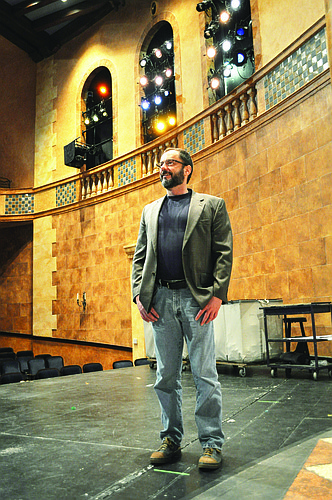- April 18, 2024
-
-
Loading

Loading

When Ken Yunker was a student at the University of Michigan, he thought he wanted to be a concert pianist. However, early into his training, stage fright crippled his fingers, so he decided to switch to voice lessons.
But that didn’t make it any better.
His voice teacher told him he had the pipes for singing, but that the support in his diaphragm was missing.
His voice was too young, too wobbly for opera.
Yunker was told to come back when he was 35, which at the time felt like eons away.
“At that point, I figured, ‘Why fight it?’” Yunker says. “That’s when I turned to lighting.”
Yunker, 45, had always had a fascination with theater, in particular backstage technical work. He found it an escapism.
Growing up in Richland, Wash., — home to the military’s Handford Nuclear Project for which his father, a nuclear chemist, and his grandfather, a physicist, worked — Christmas was Yunker’s favorite time of year.
“It was a pretty government-structured town,” Yunker says. “The only time of year when things came to life was Christmas when people put their lights out. All of a sudden it became this beautiful place.”
Raised by a family of scientists, Yunker felt pressure to follow in his father’s and grandfather’s footsteps.
That all changed in junior high school, when Yunker’s brother came home one day gushing about
operating the follow spotlight for the school’s theater department.
Uninspired by science and disenchanted by the dismal landscape of a town built on plutonium, Yunker decided to join the school’s stage crew. In 1976, he received his first paycheck for running the follow spotlight for a community-theater company.
His parents figured it was a passing phase.
“They kept nudging me toward a career in chemistry or biology,” Yunker says. “It was like, ‘The theater stuff is nice, but one day you’ll have a real job.’”
In 28 years of working as a lighting designer, Yunker has never been without work.
Based in Atlanta, Yunker, now in his fifth season as Sarasota Opera’s resident lighting designer, has designed the lighting for more than 500 operas, ballets and theater works.
His resumé includes stints at the Lyric Opera of Chicago, Utah Symphony, New Orleans Opera, Tulsa Opera, Knoxville Opera, San Antonio Opera, Opera New Jersey, Nevada Opera and Atlanta’s Tony Award-winning Alliance Theatre Company, for which Yunker currently serves as the principal lighting designer.
“What I love about lighting is that you create this artistic vision in your head and then you produce it using all these tools,” Yunker says. “If you do it right, the art emerges through the technology.”
TRICKS OF THE TRADE
According to Ken Yunker, ingenuity and resourcefulness often trump expensive technology in the opera lighting business.
Some of the best lighting effects Yunker has ever created have been inexpensive and relatively simple to design. Here are two of his favorites:
The fire flicker
When a scene calls for a lit fireplace or stove, Yunker will wire fluorescent lighting with regular non-fluorescent bulbs.
The pairing creates a flicker effect that perfectly mimics a flickering fire.
“It’s one of the oldest tricks in the book,” Yunker says. “The old guys like me who’ve been in this business for a while always fall back on it when we need to create fire. It’s so simple and realistic.”
The star drop
For romantic day-to-night scene changes, Yunker likes to use his star drop effect, which he created by taking apart a Swarovski crystal chandelier and stringing individual crystals on transparent spools of thread.
The crystals, which function as stars, can hang within a painted backdrop throughout the course of a show and the audience will never notice they’re there. That is, until the lights go out on stage and only the crystals are lit, producing what Yunker calls a “winky, blinky” star effect.
Yunker’s crystal star drop has been used in Sarasota Opera’s “Madame Butterfly” and “Tosca.”
The lighting always draws gasps from the audience.
IF YOU GO
Sarasota Opera’s winter season opens at 4 p.m. Saturday, Feb. 5 with Puccini’s “La bohème.” The show runs through Saturday, March 19. For tickets, call 366-8450 or visit www.sarasotaopera.org.
Contact Heidi Kurpiela at [email protected]